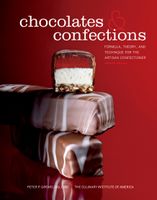Label
All
0
Clear all filters
Save 25% on ckbk Premium Membership with code FALLFLAVORS 🍁
Balance in Bar Form
Appears in
By Peter Greweling and Culinary Institute of America
Published 2007
Making artisan layered candy bars requires a working understanding of each of the centers involved and how the centers and inclusions may interact. One layer impacts another in terms of moisture migration, fat migration, sensitivity to heat, and ease of cutting and handling. All this must be considered in light of the flavors and textures each center brings to the finished bar.
The best composite candy bars are a study of contrasting and complementary flavors, textures, and colors. If one component of a bar is very soft and sweet—like a white chocolate ganache—others should provide contrasting flavors such as the tartness of fruit or the bitter edge of a dark caramel and should balance the soft texture with crunch, chewiness, or another contrasting mouthfeel. Contrasting colors add considerable visual interest to bars that are designed to be eaten in more than one bite. When properly formulated and constructed, a bar should have elements that work together so that the finished product is neither too sweet nor too chewy, too firm, too tart, or too rich; all the components must work together to create precisely the desired balance.
Become a Premium Member to access this page
Unlimited, ad-free access to hundreds of the world’s best cookbooks
Over 160,000 recipes with thousands more added every month
Recommended by leading chefs and food writers
Powerful search filters to match your tastes
Create collections and add reviews or private notes to any recipe
Swipe to browse each cookbook from cover-to-cover
Manage your subscription via the My Membership page
Best value
Part of
Advertisement
Advertisement
The licensor does not allow printing of this title


